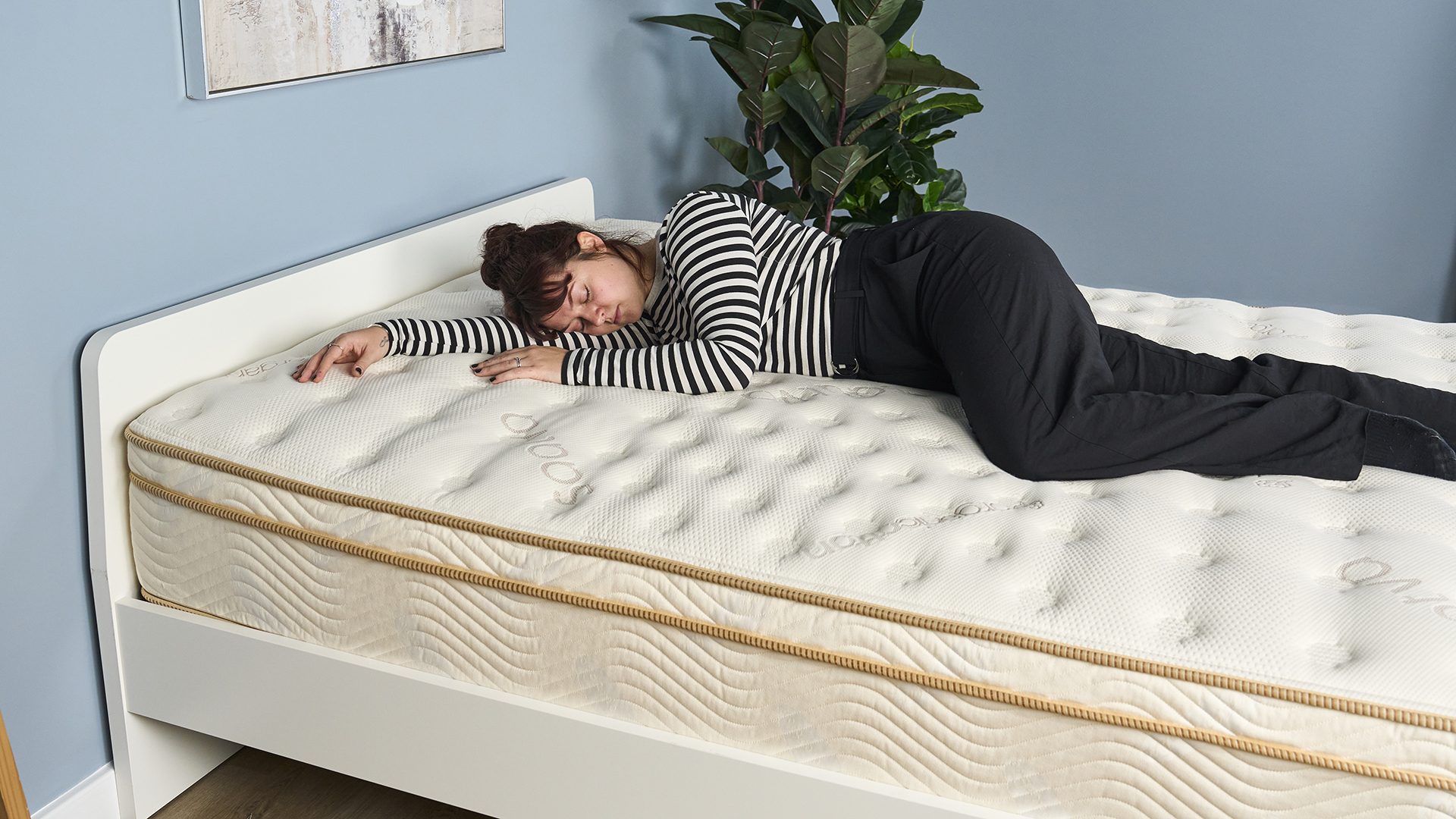What is pressure relief in a mattress and why is it important for hip and back pain during sleep?
Pressure relief in a mattress can soothe hip and back pain — here's how

The right mattress for you is the one with the greatest amount of pressure relief for your sleep style — but what exactly is pressure relief? It's a phrase that you've likely come across when hunting for a new mattress, and it's usually used in reference to hip and back pain.
Pressure relief all comes down to the parts of your body that hit the surface of the mattress first, which is why pressure relief is so important for pain prevention and reduction. Here, we'll explore in further detail what pressure relief is, why it's so important to those who suffer with hip and back pain, and which are the best mattresses on the market to relieve pressure points.
We'll also take a look at some of the best materials and mattress designs for providing pressure relief to different sleep styles, so you know what to look out for when searching for a new bed in this month's mattress sales. Let's get started.
What is pressure relief in a mattress?
When you're lying in bed, you may have noticed that some parts of your body come into contact with the mattress more than others. This contact creates pressure, so the body parts that come into contact with the bed are called pressure points.

Pressure points vary depending on sleep style. For instance, if you sleep on your side, your pressure points are in the knees, hips, and shoulders. Front sleepers, on the other hand, experience pressure in their midsection, and the hips are the main pressure points for back sleepers.
When these pressure points are supported or cushioned, this is called pressure relief. Pressure relief distributes a sleeper’s weight evenly, soothing and reducing pressure at the main pressure points. Pressure relief is particularly important to consider if you want to know how to choose a mattress for your sleep position.
Why is pressure relief important in mattresses?
Pressure relief supports or cushions the body parts that are pressed against the mattress, creating a more comfortable sleep. Mattresses provide pressure relief in different ways according to your sleep style.
Get instant access to breaking news, the hottest reviews, great deals and helpful tips.
For example, side sleepers need sink-in soft pressure relief to cushion their shoulders and hips, otherwise these pressure points will feel hard against the mattress, leading to discomfort, soreness, and even aches and pains. In contrast, stomach sleepers need firmer pressure relief so their hips can feel well supported and in line with the rest of the body.
Why is pressure relief especially important for people with hip and back pain?
Everyone will benefit from a certain degree of pressure relief from their mattress, but when choosing a mattress for back and hip pain it's important to look for ample pressure relief. Why? Because oftentimes a lack of pressure relief is the main cause of the aches and pains in the first place.

For example, side sleepers should have extra cushioning to allow pressure points in the hips and shoulders to sink in while supporting the rest of the body and keeping correct spinal alignment. If you find that you're often waking up with shoulder and hip pain, this may be because those pressure points aren't being soothed or cushioned enough while you sleep.
However, while side sleepers need a thick, sink-in soft comfort layer for extra pressure relief along the hips and shoulders, this plush type of relief may cause trouble for stomach sleepers.
If you lie on your front on a soft bed, this will cause your hips to dip into the mattress and your spine to become misaligned. This misalignment can cause the lumbar zone (i.e. the lower back) to feel unsupported and leads to back pain. That's why both stomach and back sleepers need a firm or medium firm bed for good weight distribution to support their lumbar region.
What are the signs of poor pressure relief in a mattress?
There are many different signs that your mattress may not be providing you with the right kind of pressure relief for your sleep style or weight. If you sleep on your side, and your mattress feels hard against your pressure points or you wake up with joint pain, then your mattress needs to be softer and provide thicker comfort layers to cushion these pressure points. The same goes for those who weigh under 130lbs, who need a soft mattress so their lighter frames can sink in to the mattress for pressure relief
On the other hand, if you sleep on your back or front and are experiencing lower back pain, then it's a sign that your bed's pressure relief isn't firm or supportive enough, causing your hips to sag into the mattress and your spine to become misaligned. We recommend finding a firmer mattress to keep your pressure points well aligned with the spine. Heavyweight sleepers (those over 230lbs) should also look for a firm mattress to prevent their pressure points form sagging into the mattress too much.
What effects pressure relief in a mattress?
While sleep style is important to take into account when choosing a mattress there's a lot of other factors which effect pressure relief besides which body parts are pressing against the mattress. Here are some of the things that influence pressure relief:
- Body weight: As mentioned above, heavyweight sleepers (those who weigh over 230lbs) need a firm mattress so their pressure points can be supported and well aligned, while lightweight sleepers (under 130lbs) need something soft to cushion their pressure points.
- Mattress type: The type of mattress you buy should suit your sleep style if you want the best pressure relief. Typically, the best memory foam mattresses and the best hybrid mattresses tend to provide excellent pressure relief, along with beds that use latex.
- Materials: To provide a good amount of pressure relief over time, the materials need to last and not succumb to sagging, which leads to pressure points becoming unsupported. Latex is the most long-lasting material, followed by thick, durable foam such as HRX foam. Mattresses that use springs and coils, such as innerspring and hybrid beds, have a tendency to sag quicker as springs can wear out quite easily.
- Bed-sharing: The more people in a bed, the more pressure is placed on the mattress, so you'll need a mattress with a good amount of pressure relief if you co-sleep.
- Room temperature and climate: Temperature can affect a mattress's firmness levels, meaning a warm room can soften a mattress, while a cold room can make it firmer.
What are the best types of mattresses for pressure relief?
The best type of mattresses for pressure relief depends on the above factors. The best mattresses for side sleepers and petite bodies tend to be made from memory foam, thanks to the cushioning, body-cradling 'hug' it provides to hips and shoulders. It also moulds to the body in response to weight and heat, meaning shoulders and hips shouldn't feel uncomfortable when pressed against its surface.

On the other hand, the best mattresses for stomach sleepers and those with heavier bodies suit firmer mattresses such as hybrid and latex. Latex is durable and strong, meaning there's little sinkage or sagging, so hips will stay up and spine will stay well aligned.
The best medium-firm mattresses can suit all kinds of sleepers, but remember that firmness ratings vary from mattress to mattress. As they combine the flexibility of foam with providing sturdy support, hybrids promote good spinal alignment and zoned support for key areas, such as the hips and lower back. Plus, tiers of pocketed coils or individually wrapped springs are also known for adapting to the spine.
Can you improve pressure relief in a mattress?
Yes, you can improve the pressure relief of your mattress by either making it firmer or softer, depending on your preference. If you're looking for ways to make your mattress firmer, you could make sure you're bedroom isn't too warm or check to see if your bed base is tight enough. Those who want a softer mattress should make sure their room isn't too cold.

However, a sure-fire way of adjusting the pressure relief of your mattress (without having to buy a new mattress, that is) is investing in a mattress topper. The best mattress toppers can make your mattress softer or firmer, depending on the bed topper's materials.
If you can't decide on a mattress topper or don't know what kind you need, we strongly reccomend taking a look at our guide on how to choose a mattress topper. Our Tempur-Pedic Tempur-Adapt topper review found the cloud-like topper to provide deep pressure relief fore side sleepers, while our Viscosoft Active Cooling Mattress Topper review found the cooling topper to be firm and supportive enough for back sleepers.

Frances Daniels is a PPA-accredited journalist and Sleep Staff Writer at Tom's Guide with an MA in Magazine Journalism from Cardiff University. Her role includes covering mattress and sleep news and writing sleep product reviews and buyer's guides, including our Best Hybrid Mattress 2025 guide. She is interested in the relationship between sleep and health, interviewing an array of experts to create in-depth articles about topics such as nutrition, sleep disorders, sleep hygiene, and mattress care. She is also our specialist on mattress toppers — producing bed topper reviews and taking care of our Best Mattress Toppers 2025 guide — and leads content relating to fiberglass-free beds for a non-toxic sleep. Outside of Tom's Guide, she has written for Ideal Home and Marie Claire.
You must confirm your public display name before commenting
Please logout and then login again, you will then be prompted to enter your display name.
